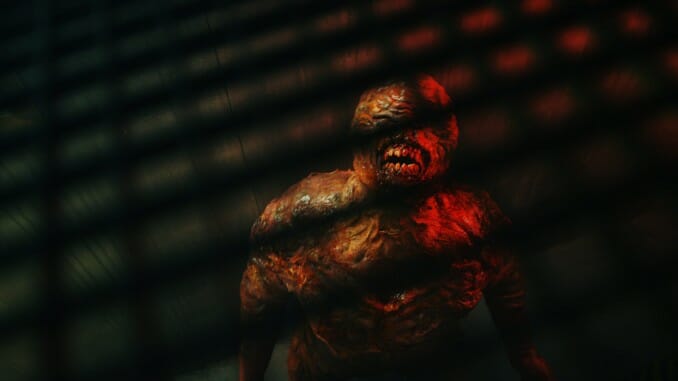In Death Valley, You’ll Find a Good Creature, but a Bad Feature

Shudder’s latest premiere, Death Valley, boasts gore-forward creature thrills with an emphasis on tight quarters (Ridley Scott’s ears are burning). Director and screenwriter Matthew Ninaber—notably billed as the hunky actor underneath Psycho Goreman extraterrestrial flesh—once again transforms beneath prosthetics and cosmetics that honor the sacred art of practical monster effects. Confident SFX applications never fall victim to the digitization of demons or thick shadows that hide rushed warehouse imperfections. Still, an inefficient supporting narrative around the film’s prized predator rears an uglier head over time. It’s as repetitive and underwritten as any Resident Evil knockoff can be—might as well be a T-Virus or G-Virus outbreak—with mediocre military diversions that pull us away from the reanimated nightmares at hand.
Matthew’s brother Jeremy Ninaber stars as gun-for-hire Beckett, a soldier with parenthood on the horizon who’s accepted his proclaimed last contract. Beckett’s sex-obsessed partner Marshall (Ethan Mitchell)—quite the introductory banter—shows best friend supportiveness aside from crude humor, which adds a layer of importance to their objective. It’s a simple extraction job, as militia guards patrol some European Cold War bunker with their target inside: Bioengineer Chloe (Kristen Kaster). Sneak in, rescue the asset, haul ass home—what’s there to worry about (he types rhetorically)?
As we glimpse in the film’s opening scene, where Chloe is locked inside the subterranean facility by the mountain of muscle that forms villain Olek (Matt Daciw), armed ranks aren’t Beckett’s only problem. Matthew Ninaber’s genetic hybrid of a creature bears a striking resemblance to both Lickers and Nemesis from the Resident Evil universe, stalking the halls where Chloe now cowers. Death Valley’s introduction isn’t shy about reveals—Chloe confronts Ninaber’s beast as it outreaches curled claws and hisses a snarl towards the trembling woman. A worse movie wouldn’t dare afford audiences such a full-frontal view so early, while a better one might spend less time outside the concrete enclosure as Beckett plays assault rifle heroics.
After Ninaber engages horror fans by unleashing his nightmare, Death Valley trades labyrinthian claustrophobia for Beckett’s mundane black ops gunplay. It’s narratively necessary to eliminate Beckett and Marshall’s reinforcements and strand them inside with Chloe’s coworkers turned inhuman outbreak spreaders—well, the single hellspawn we see in frame per interaction due to production limitations. If only the extended war games didn’t feel like Ninaber’s family and frequent collaborators were dashing around someone’s backyard with fake weapons. There’s no reason to divert attention away from creatures for what seems like almost the entire front half of Death Valley, sans the first sequence, and favor the incomparably dull woodland combat that’s nothing but recycled action movie dialogue and grunts eating bullets.
-

-

-

-

-

-

-

-

-

-

-

-

-

-

-

-

-

-

-

-

-

-

-

-

-

-

-

-

-

-

-

-

-

-

-

-

-

-

-

-








































